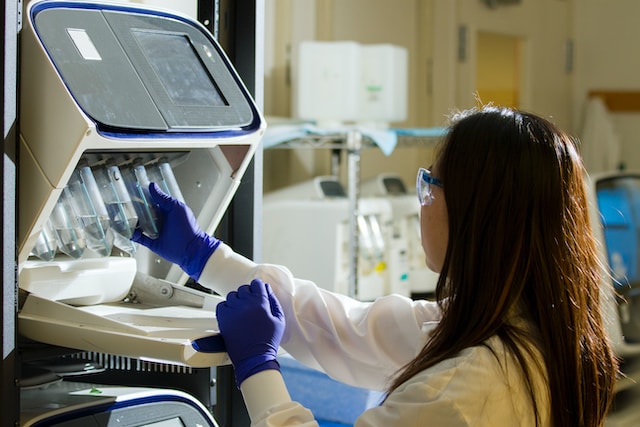服务咨询热线
400-8393-288
周一至周五: 8:30-17:30
法定节假日休息
科学家通过合成“基因震荡器”延长细胞寿命,实现高效抗衰
衰老是一个复杂的生物学过程,是人类寿命和许多疾病的基础,而人类的寿命与个体细胞的衰老有关。近日,加州大学圣地亚哥分校郝楠团队通过合成生物学重新编程细胞衰老的过程,在酵母细胞内设计了一个合成基因振荡器,将酵母细胞寿命延长了82%。

酵母细胞有一个转录开关,导致它们以两种方式中的一种死亡:一种是核仁衰退,另一种是线粒体衰变。通过将这种转录开关重新连接到负反馈回路中,能够使酵母细胞在两种状态之间振荡,并将其寿命延长。
The pioneering method, which was found to work in yeast cells, requires genetically rewiring a circuit to allow the cells to continuously oscillate between two deteriorative processes instead of succumbing to either.
研究人员对细胞回路进行基因重组,通过切换和调控细胞在两种不同衰老路线中的行进,从而延缓细胞衰老。
The result is an increased cellular lifespan through a delay in the commitment to aging.
通过延缓衰老过程,从而有效延长寿命。
Molecular biology professor Nan Hao described the circuit responsible for aging as a “toggle switch” that triggers the cells' progression toward death.
郝楠称,控制衰老的回路就像一个触发细胞死亡程序的拨动开关。
“This is the first time computationally guided synthetic biology and engineering principles were used to rationally redesign gene circuits and reprogram the aging process to effectively promote longevity,” Hao said in a statement.
郝楠表示:“这是第一次利用计算引导的合成生物学和工程原理来合理地重新设计基因回路和重新编程衰老过程,从而有效地延长寿命。”
Hao believes the process can eventually be replicated to apply to humans.
郝楠认为这个过程最终可以被复制以应用于人类。
In a commentary, Howard Salis, an associate professor of biological and chemical engineering at Penn State University, said human cells contain similar — albeit more complex — age-committing genetic circuitry, making the same method of rewiring a possibility.
宾夕法尼亚州立大学生物和化学工程副教授霍华德·萨利斯评论称,人类细胞存在类似的,但更复杂的衰老相关遗传回路,这使得重新布线的方法成为可能。
The recent study, titled “Engineering longevity — design of a synthetic gene oscillator to slow cellular aging,” was published in the journal Science last week.
该研究论文上周发表在《科学》期刊,题目为《编辑长寿,研究设计一种合成基因振荡器减缓细胞衰老》。
编辑:董静,李蕙帆(实习)
来源:Next Shark,澎湃新闻
图文来源:Next Shark,澎湃新闻,Unsplash等综合整理,新闻资讯均转载自其它媒体,目的在于传播更多信息,其他媒体如需转载,请与稿件来源方联系,如产生任何问题与本网无关;本网所发布的内容,图片,音乐,电影等片段,版权归原作者所有,仅供学习与研究,如果侵权,请提供版权证明,以便尽快删除。
- 上一条:有氧运动和肌肉训练可降低死于流感和肺炎的风险
- 下一条:五月最值得一看的5部海外新片
-
字字千钧,法意无界,亚加达翻译高效护航,值得拥有!2025-06-23
-
印度亿万富翁吞下一只蜜蜂后猝逝2025-06-17
-
发现“超级地球”!可能存在类地生命2025-06-06
-
全球好感度最新调查:中国8.8,美国-1.52025-06-04
-
首次发生!不听人类指挥,AI模型拒绝关闭2025-05-28
-
哈佛禁招令,比利时未来女王也被影响了2025-05-26
-
两个发胖时段,熬过去就能瘦?2025-05-21
-
首次公布!我国空间站内发现新物种2025-05-19
-
关于邀请各省区市翻译协会组织人员报名参加第三届全国翻译技术大赛的函2025-05-15
-
关于邀请各省区市翻译协会组织人员报名参加第三届全国翻译技术大赛的函2025-05-15
-
许昌对胖东来开展检查,结果公布2025-05-06
-
苏炳添,任院长!2025-04-28
-
中国翻译协会发布《2025中国翻译行业发展报告》和《2025全球翻译行业发展报告》2025-04-28
-
“中国人不怕,中国人能吃苦!”2025-04-21



